Characterization of a Non-Darcy Flow and Development of New Correlation of NON-Darcy Coefficient
Abstract
1. Introduction
2. Experimental Methodology
2.1. Experimental Setup
2.2. Porous Media Selection
2.3. Core Preparation
3. The Determination of a Non-Darcy Flow
Hydraulic Gradient-Velocity
4. Experimental Results and Analysis
4.1. Hydraulic Gradient-Velocity Equations
4.2. The Flow Rate and Pressure Gradient
5. Porosity Effect
6. Correlation of Non-Darcy Coefficient
7. Tortuosity
8. Conclusions
- There are many methods for calculating the non-Darcy coefficient in the literature using flow velocity and the combined action of the displacement medium (liquid) and the porous media. This includes using the Reynolds number, the Forchheimer number, or analyzing pressure and flow data.
- The data were collected using seven large samples in this paper, and the flow was radially considered uncommon in the literature. In total, 358 experiments were conducted. Water and air were used as operating fluids.
- This study produced two reliable equations, one of which considered tortuosity an important parameter. Many researchers have recently argued that it should be included in the correlations. This work can be extended by experimenting with other fluids such as oil, CO2, etc. Additionally, more samples with different porosity and permeabilities will produce more β points.
Author Contributions
Funding
Data Availability Statement
Conflicts of Interest
Nomenclature
| β | non-Darcy coefficient |
| φ | Porosity |
| k | Permeability |
| kr | Relative permeability |
| τ | Tortuosity |
| ρ | Density |
| ʋ | Viscosity |
| v | Fluid velocity |
| P | Pressure |
| g | Gravity |
| i | Hydraulic gradient |
| f | Friction factor |
| re | Shape factor efficiency |
| R | Hydraulic mean radius |
| Re | Reynolds number |
| Sw | Water saturation |
| a, b | Are constants calculated experimentally |
| M.P.D. | Mean pour diameter |
| M.I.P. | Mercury intrusion porosimetry |
References
- Andrade, J.S.; Costa, U.M.; Almeida, M.P.; Makse, H.A.; Stanley, H.E. Inertial Effects on Fluid Flow through Disordered Porous Media. Phys. Rev. Lett. 1999, 82, 5249–5252. [Google Scholar] [CrossRef]
- Hill, R.J.; Koch, D.L.; Ladd, A.J.C. The First Effect of the Fluid Inertia on Flows in Ordered and Random Arrays of Sphers. J. Fluid Mech. 2001, 448, 213–241. [Google Scholar] [CrossRef]
- Cheng, H.; Papanicolaou, G. Flow past periodic arrays of spheres at low Reynolds number. J. Fluid Mech. 1997, 335, 189–212. [Google Scholar] [CrossRef]
- Wu, Y.-S.; Lai, B.; Miskimins, J.L.; Fakcharoenphol, P.; Di, Y. Analysis of Multiphase Non-Darcy Flow in Porous Media. Transp. Porous Media 2011, 88, 205–223. [Google Scholar] [CrossRef]
- Cattaneo, L.; Comunian, A.; De Filippis, G.; Giudici, M.; Vassena, C. Modeling Groundwater Flow in Heterogeneous Porous Media with YAGMod. Computation 2016, 4, 2–19. [Google Scholar] [CrossRef]
- Ghahri, P.; Jamiolahmady, M. A new, accurate and simple model for calculation of productivity of deviatedand highly deviated well – Part I: Single-phase incompressibleand compressible fluid. Fuel 2012, 97, 24–37. [Google Scholar] [CrossRef]
- Ni, X.; Kulatilake, P.; Chen, Z.; Gong, P.; Kong, H. Experimental Investigation of Non-Darcy Flow in Sandstone. Geotech. Geol. Eng. 2016, 34, 1835–1846. [Google Scholar] [CrossRef]
- Akihiro, T.; Xiaopeng, Z.; Taku, T.; Mitsuru, K. Topology optimisation of a porous unit cell in a fluid flow considering Forchheimer drag. Int. J. Comput. Fluid Dyn. 2020, 34, 50–60. [Google Scholar]
- Ovalle-Villamil, W.; Sasanakul, I. Investigation of Non-Darcy Flow for Fine Grained Materials. Geotech. Geol. Eng. 2019, 37, 413–429. [Google Scholar] [CrossRef]
- Partha, K.; Vimal, K.; Lausanne, M. Experimental and numerical investigation of fluid flow hydrodynamics in porous media: Characterization of pre-Darcy, Darcy and non-Darcy flow regimes. Powder Technol. 2016, 303, 278–291. [Google Scholar]
- Yang, Y.; Huiqing, L.; Ling, X.; Meng, Z. Experimental study of non-darcy two-phase flow in a fractured—Vuggy medium. Chem. Technol. Fuels Oils 2016, 52, 36–40. [Google Scholar] [CrossRef]
- Wheeler, M.; Balhoff, M. A Predictive Pore-Scale Model for Non-Darcy Flow in Porous Media. SPE J. 2009, 14, 579–587. [Google Scholar]
- Hassanizadeh, S.M.; Gray, W.G. High Velocity Flow in Porous Media. Transp. Porous Media 1987, 2, 521–531. [Google Scholar] [CrossRef]
- Ergun, S.; Orning, A. Fluid Flow through Randomly Packed Columns and Fluidized Beds. Ind. Eng. Chem. 1949, 41, 1179–1184. [Google Scholar] [CrossRef]
- Dacun, L.; Robert, S.; Tom, E.; Reid, G. Modeling and Simulation of the Wafer Non-Darcy Flow Experiments. In Proceedings of the SPE Western Regional Meeting, Bakersfield, CA, USA, 26–30 March 2001. [Google Scholar]
- Macdonald, F.; Mow, E.S.K.; Dullien, L. Flow through Porous Media-the Ergun Equation Revisited. Ind. Eng. Chem. Fundam. 1979, 18, 199–208. [Google Scholar] [CrossRef]
- Janicek, J.; Katz, D. Applications of Unsteady State Gas Flow Calculations; University of Michigan: Ann Arbor, MI, USA, 1955. [Google Scholar]
- Geertsma, J. Estimating the Coefficient of Inertial Resistance in Fluid Flow Through Porous Media. Soc. Pet. Eng. J. 1974, 14, 445–450. [Google Scholar] [CrossRef]
- Jones, S.C. Using the Inertial Coefficient, B, To Characterize Heterogeneity in Reservoir Rock. In Proceedings of the SPE Annual Technical Conference and Exhibition, Dallas, TX, USA, 27–30 September 1987. [Google Scholar]
- Wang, X.; Thauvin, F.; Mohanty, K.K. Non-Darcy flow through anisotropic porous media. Chem. Eng. Sci. 1999, 54, 1859–1869. [Google Scholar] [CrossRef]
- Khan, U.; Zaib, A.; Khan, I.; Nisar, K.S.; Baleanu, D. Insights into the Stability of Mixed Convective Darcy–Forchheimer Flows of Cross Liquids from a Vertical Plate with Consideration of the Significant Impact of Velocity and Thermal Slip Conditions. Mathematics 2020, 1, 8. [Google Scholar] [CrossRef]
- Rahman, J.U.; Khan, U.; Ahmad, S.; Ramzan, M.; Suleman, M.; Lu, D.; Inam, S. Numerical Simulation of Darcy–Forchheimer 3D Unsteady Nanofluid Flow Comprising Carbon Nanotubes with Cattaneo–Christov Heat Flux and Velocity and Thermal Slip Conditions. Processes 2019, 7, 687. [Google Scholar] [CrossRef]
- Alghamdi, M.; Wakifc, A.; Thumma, T.; Khan, U.; Baleanu, D.; Rasool, G. Significance of variability in magnetic field strength and heat source on the radiative-convective motion of sodium alginate-based nanofluid within a Darcy-Brinkman porous structure bounded vertically by an irregular slender surface. Case Stud. Therm. Eng. 2021, 28, 101428. [Google Scholar] [CrossRef]
- Rahman, M.A.; Mustafiz, S.; Koksal, M.; Islam, M.R. Quantifying the skin factor for estimating the completion efficiency of perforation tunnels in petroleum wells. J. Pet. Sci. Eng. 2007, 58, 99–100. [Google Scholar] [CrossRef]
- Rahman, M.A.; Mustafiz, S.; Biazar, J.; Koksal, M.; Islam, M.R. Investigation of a novel perforation technique in petroleum wells—perforation by drilling. J. Frankl. Inst. 2007, 344, 777–789. [Google Scholar] [CrossRef]
- Zheng, L.; Rahman, M.A.; Ahammad, M.J.; Butt, S.D.; Alam, J.M. Experimental and Numerical Investigation of a Novel Technique for Perforation in Petroleum Reservoir. In Proceedings of the SPE International Conference and Exhibition on Formation Damage Control, Lafayette, LA, USA, 24–26 February 2016. [Google Scholar]
- Abobaker, E.; Elsanoose, A.; Khan, F.; Rahman, M.A.; Aborig, A.; Noah, K. Quantifying the partial penetration skin factor for evaluating the completion efficiency of vertical oil wells. J. Pet. Explor. Prod. Technol. 2021, 11, 3031–3043. [Google Scholar] [CrossRef]
- Rabbani, H.; Khan, M.; Qureshi, M.F.; Rahman, M.A.; Seers, T.; Lal, B. Analytical Modelling of Gas Hydrates in Porous Media. In Proceedings of the Offshore Technology Conference Asia, Kuala Lumpur, Malaysia, 22–25 March 2022. [Google Scholar]
- Ahammad, M.J.; Alam, M.J.; Rahman, M.A.; Butt, S.D. Numerical simulation of two-phase flow in porous media using a wavelet based phase-field method. Chem. Eng. Sci. 2017, 17, 230–241. [Google Scholar] [CrossRef]
- Rabbani, S.; Osman, H.; Almaghrabi, Y.; Rahman, A.; Seers, M. The Control of Apparent Wettability on the Efficiency of Surfactant Flooding in Tight Carbonate Rocks. Processes 2019, 7, 684–694. [Google Scholar] [CrossRef]
- Ding, L.; Cui, L.; Jouenne, S.; Gharbi, O.; Pal, M.; Bertin, H.; Rahman, M.A.; Romero, C.; Guérillot, D. Estimation of Local Equilibrium Model Parameters for Simulation of the Laboratory Foam-Enhanced Oil Recovery Process Using a Commercial Reservoir. ACS Omega 2020, 5, 23437–23449. [Google Scholar] [CrossRef] [PubMed]
- Shachi; Yadav, B.K.; Rahman, M.A.; Pal, M. Migration of CO2 through Carbonate Cores: Effect of Salinity, Pressure, and Cyclic Brine-CO2 Injection. J. Environ. Eng. 2020, 146, 04019114. [Google Scholar] [CrossRef]
- Ahammad, J.; Rahman, M.A.; Butt, S.D.; Alam, J.M. An Experimental Development to Characterise the Flow Phenomena at the Near-Wellbore Region. In Proceedings of the ASME 2019 38th International Conference on Ocean, Offshore and Arctic Engineering, Glasgow, Scotland, UK, 9–14 June 2019. [Google Scholar]
- Elsanoose, A.; Abobaker, E.; Khan, F.; Rahman, M.A.; Aborig, A.; Butt, S.D. Experimental Investigation of Single Flow through Porous Media Around Perforation Tunnel. In Proceedings of the 7th Thermal and Fluids Engineering Conference, Las Vegas, NV, USA, 15–18 May 2022. [Google Scholar]
- Wen, Z.; Huang, G.; Zhan, H. Non-Darcian flow to a well in an aquifer–aquitard system. Adv. Water Resour. 2008, 31, 1754–1763. [Google Scholar] [CrossRef]
- Sedghi-As, M.; Rahimi, H. Adoption of Manning’s equation to 1D non-Darcy flow problems. J. Hydraul. Res. 2011, 49, 814–817. [Google Scholar] [CrossRef]
- Salahi, M.-B.; Sedghi-Asl, M.; Parvizi, M. Nonlinear Flow through a Packed-Column Experiment. J. Hydrol. Eng. 2014, 9, 04015003-1–04015003-9. [Google Scholar] [CrossRef]
- Mccorquodale, J.A.; Hannoura, A.-A.A.; Nasser, M.S. Hydraulic Conductivity Of Rockfill. J. Hydraul. Res. 2010, 16, 123–137. [Google Scholar] [CrossRef]
- Kadlec, R.; Knight, R. Treatment Wetlands; Lewis Publishers: Boca Raton, FL, USA, 1996. [Google Scholar]
- Yao, Y.; Li, G.; Qin, P. Seepage features of high-velocity non-Darcy flow in highly productive reservoirs. J. Nat. Gas Sci. Eng. 2015, 24, 1732–1738. [Google Scholar] [CrossRef]
- Elsanoose, A.; Abobaker, E.; Khan, F.; Rahman, M.A.; Aborig, A.; Butt, S.D. Estimating of Non-Darcy Flow Coefficient in Artificial Porous Media. Energies 2022, 15, 1197. [Google Scholar] [CrossRef]

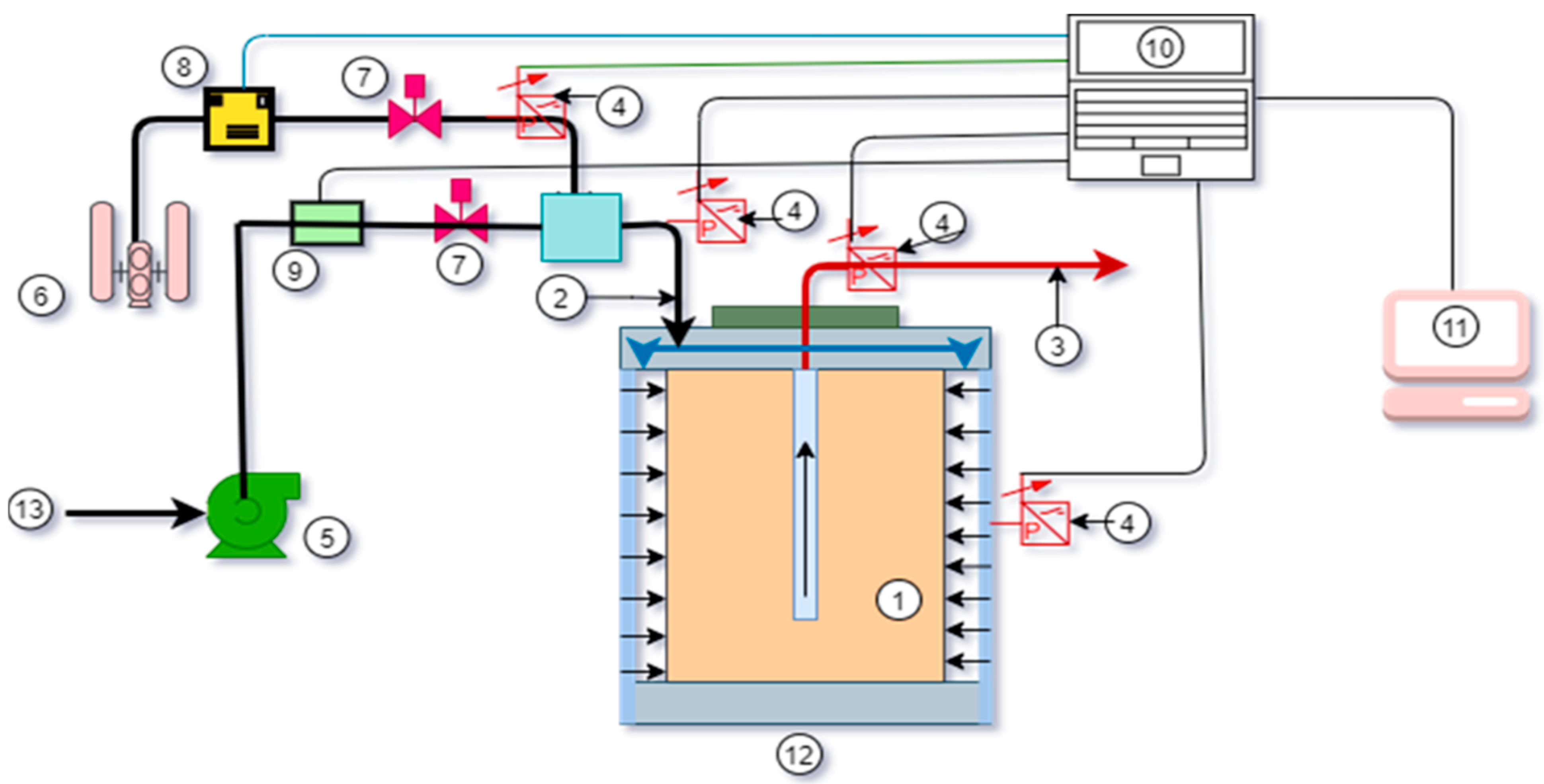
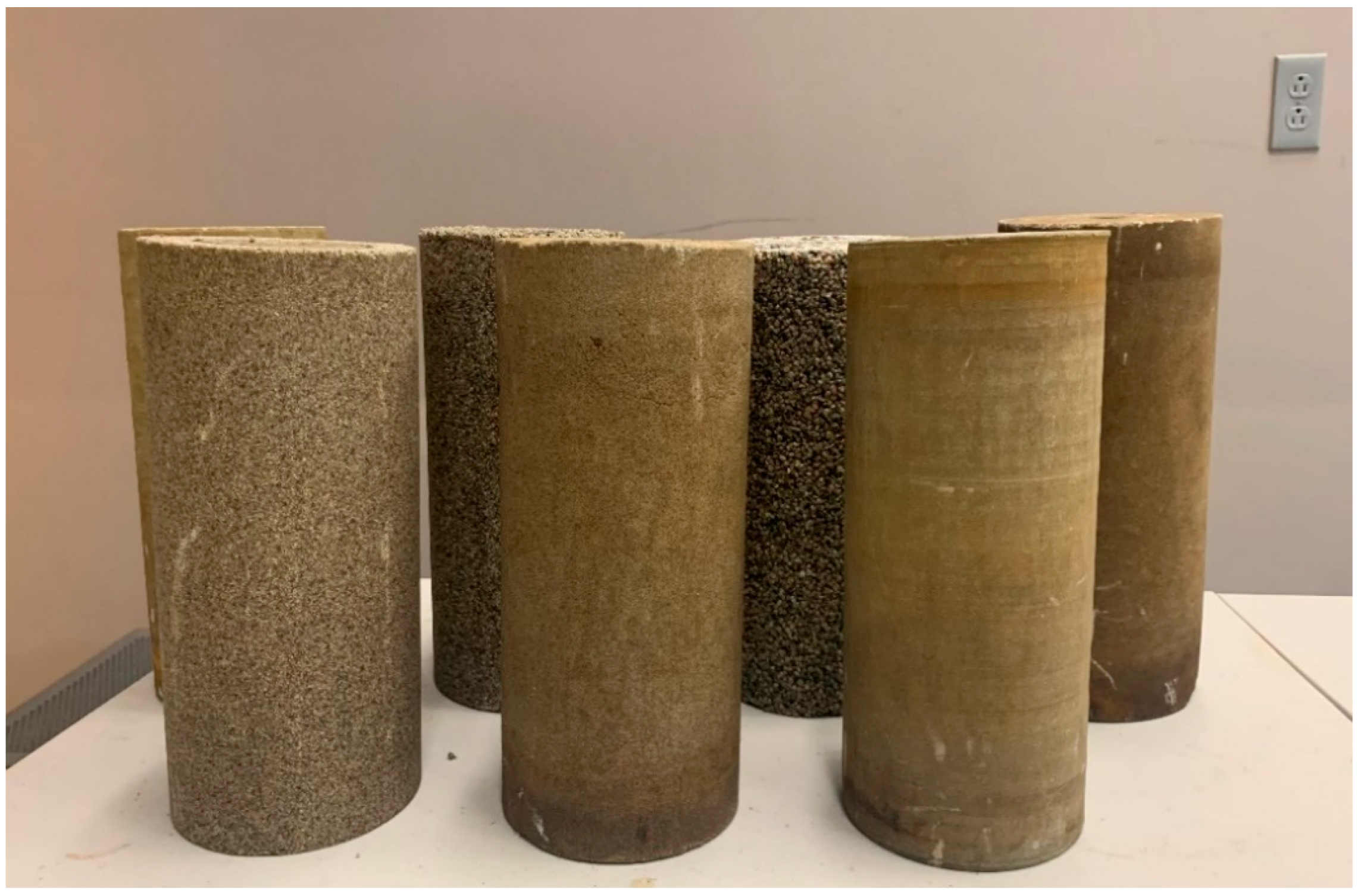
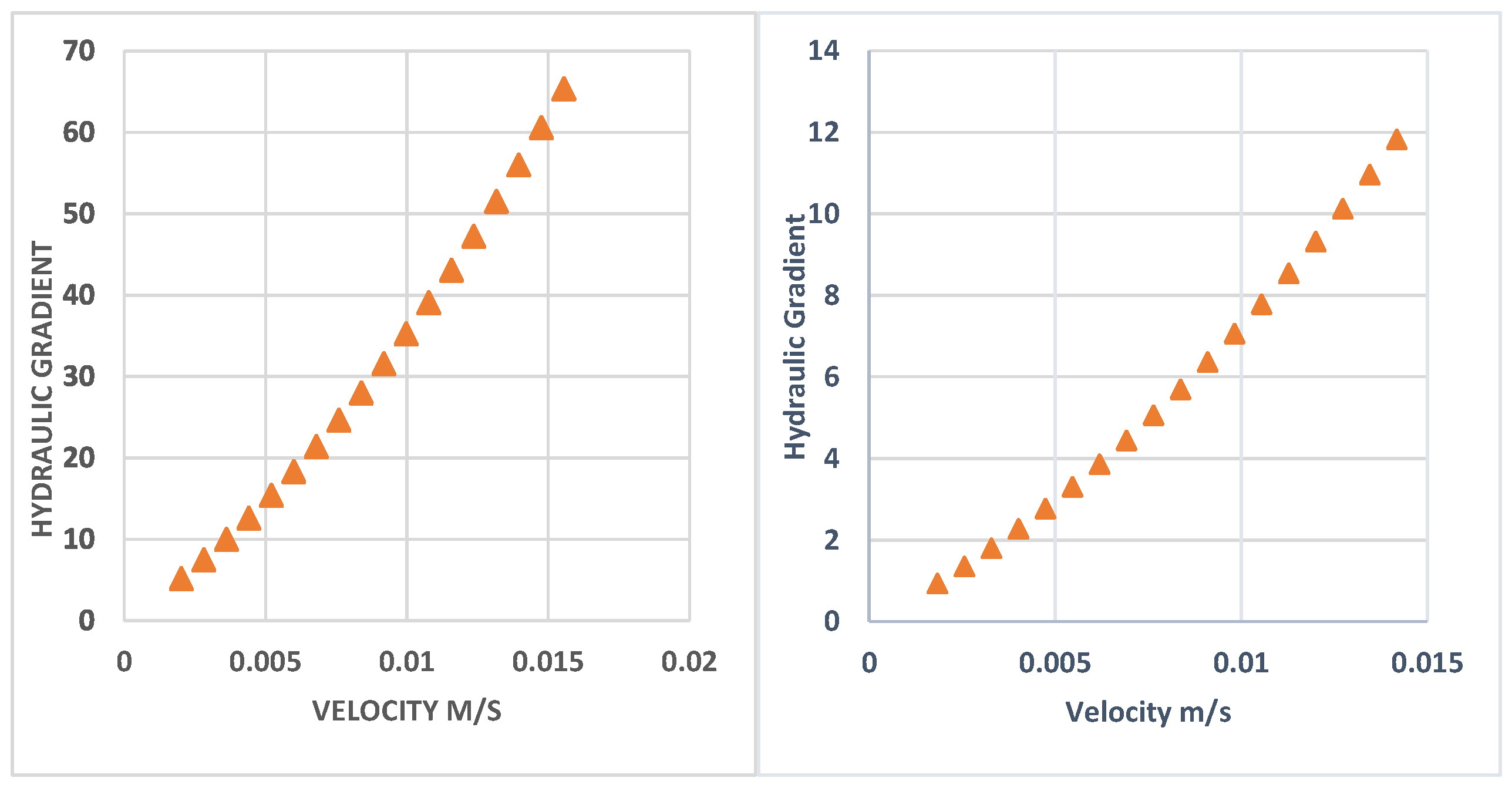

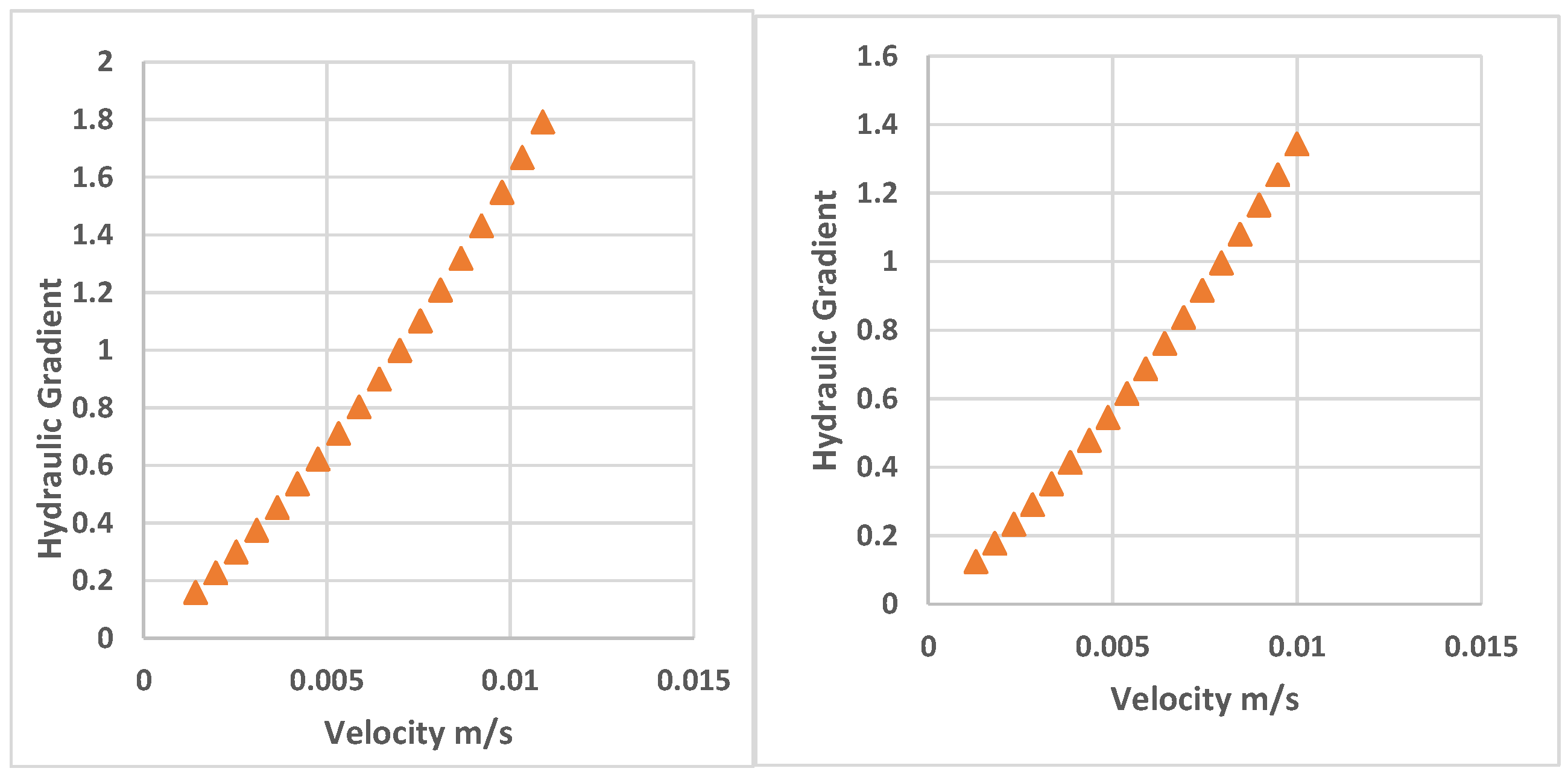
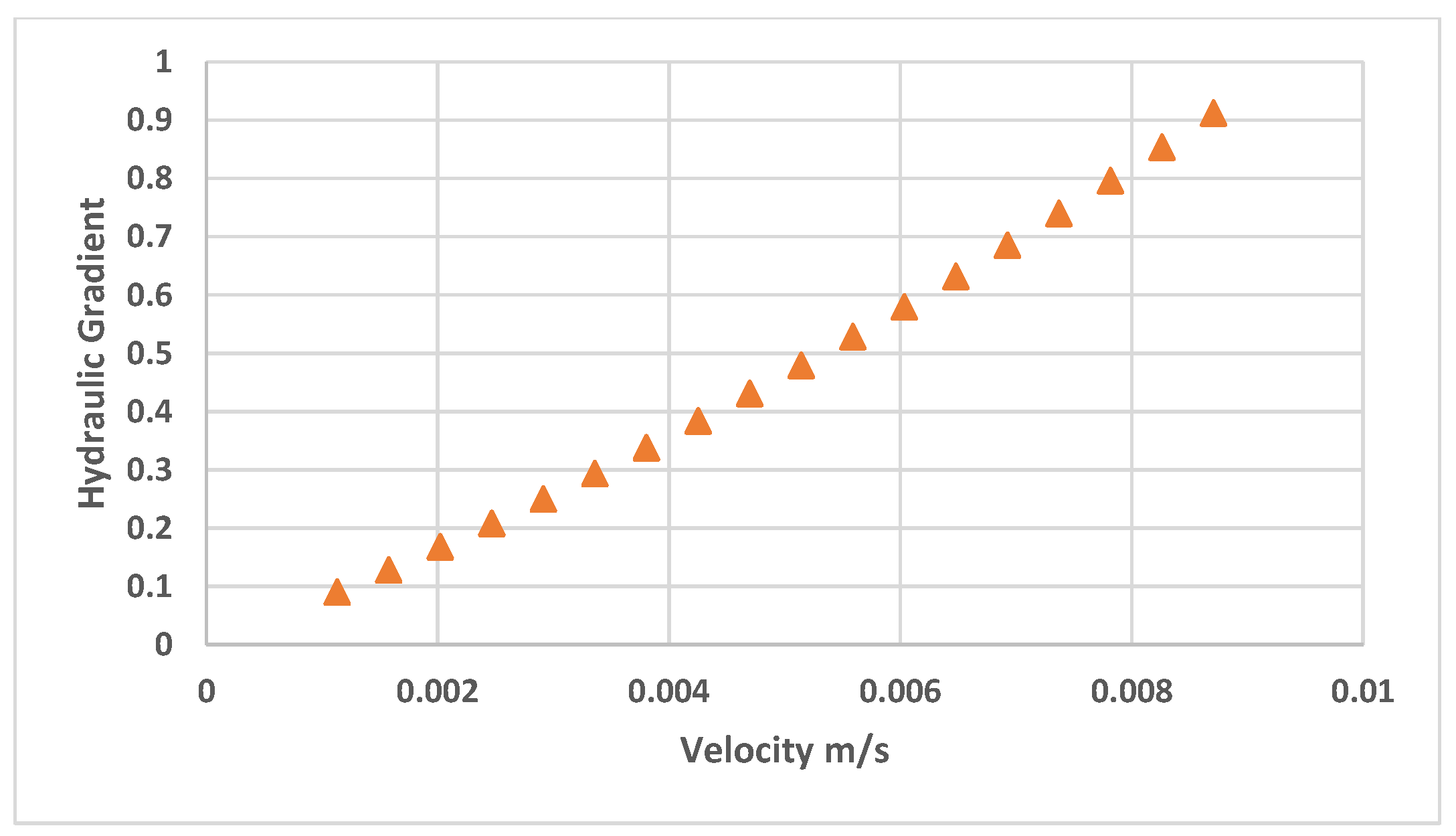
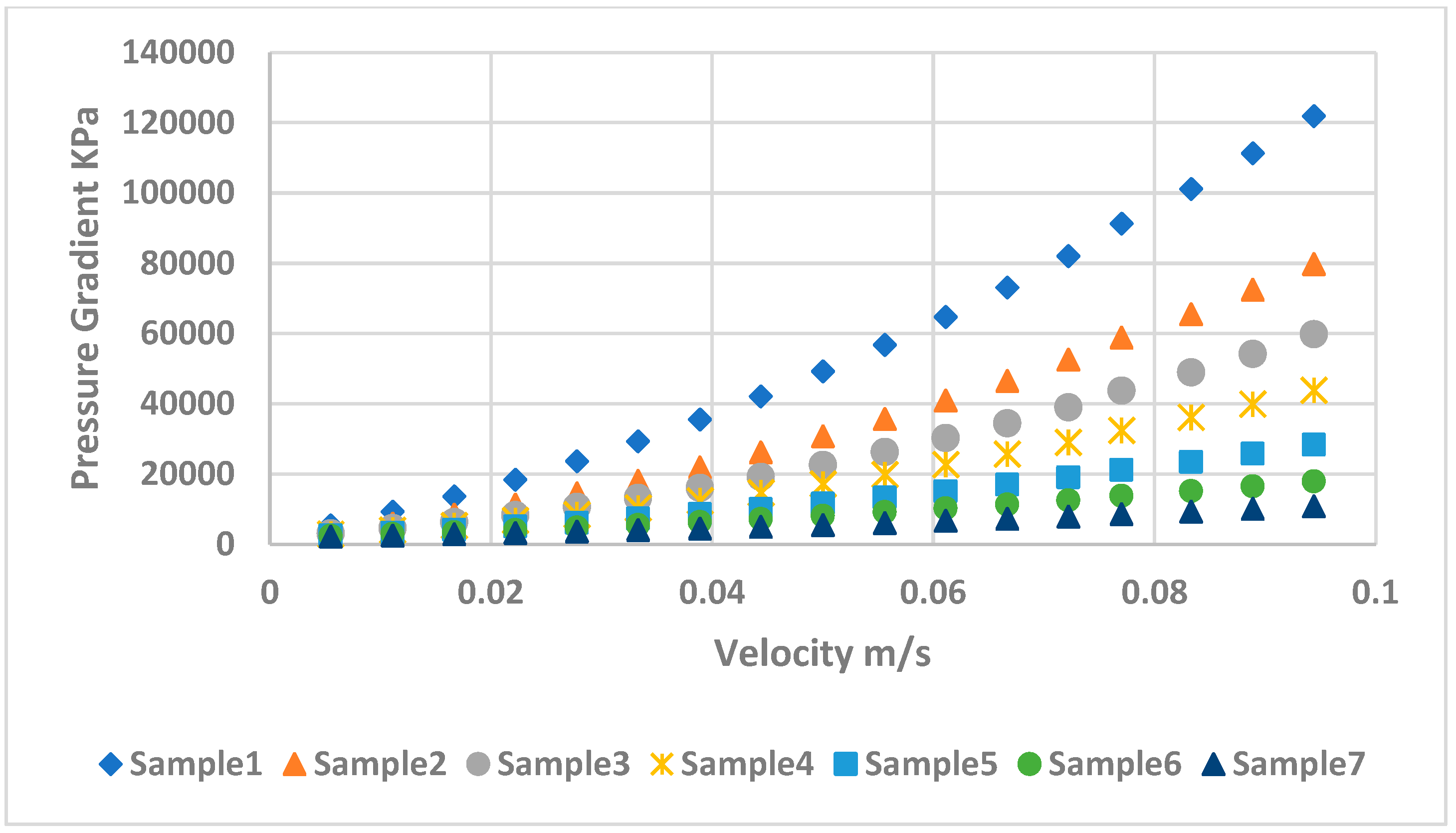
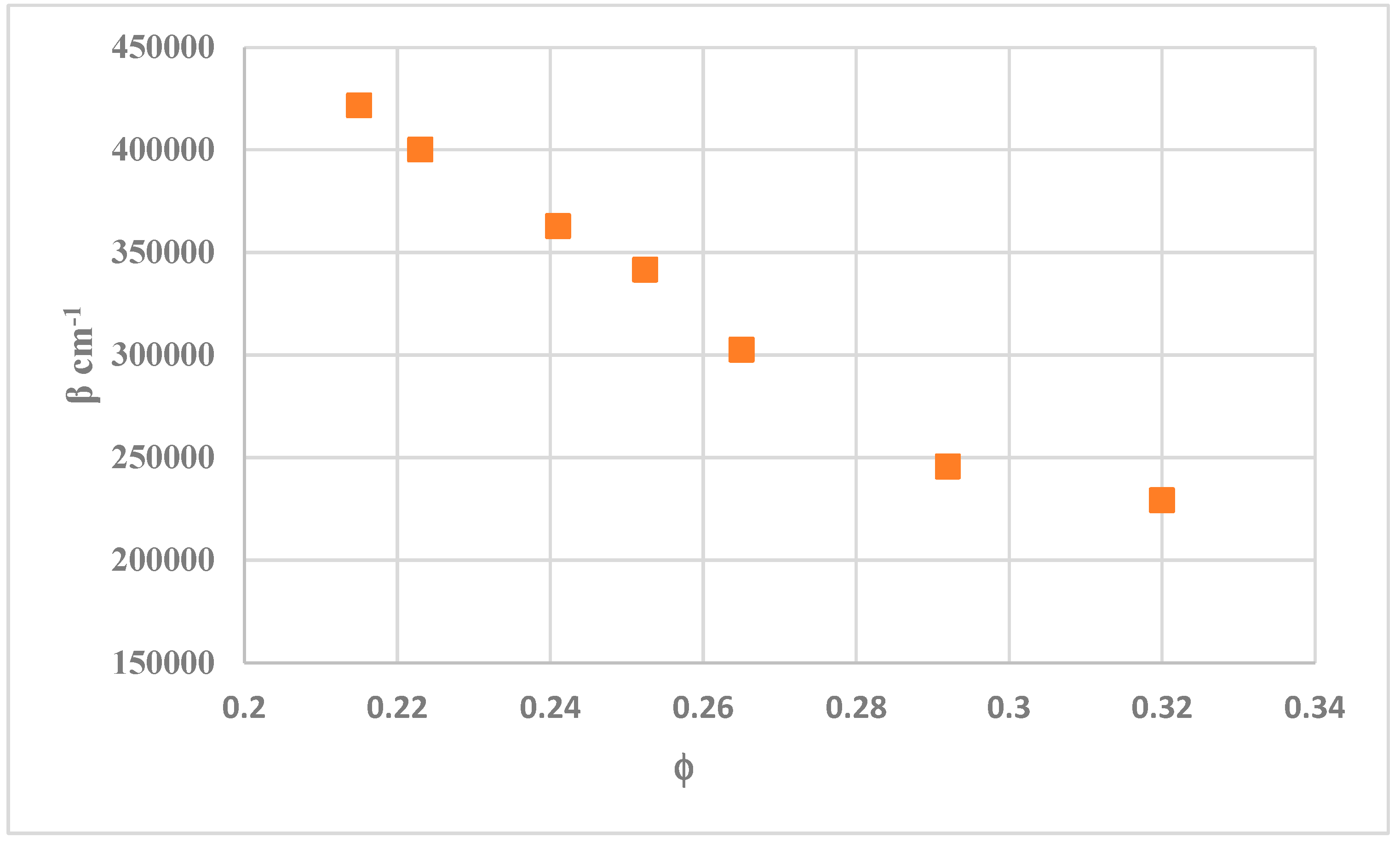

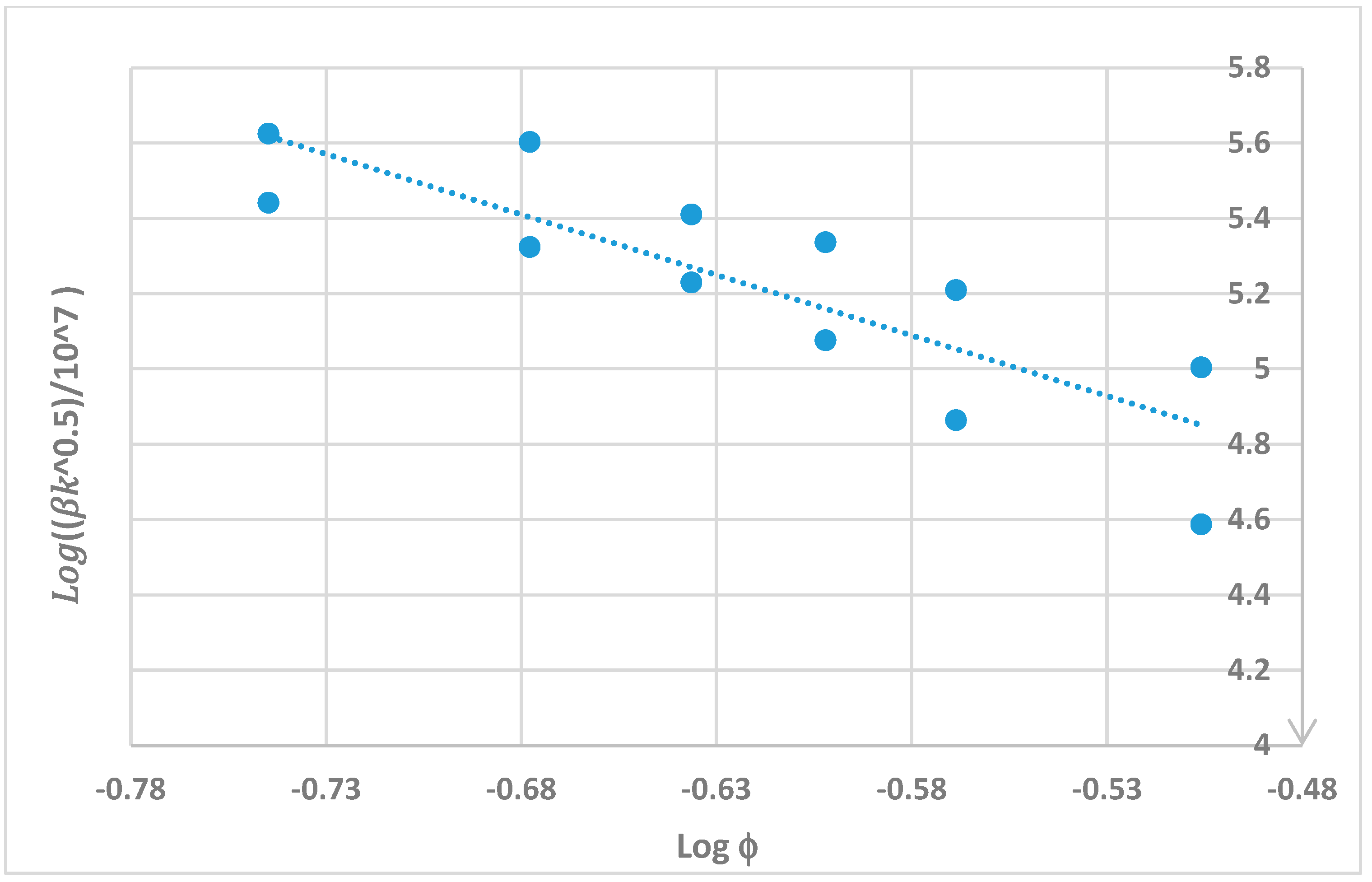
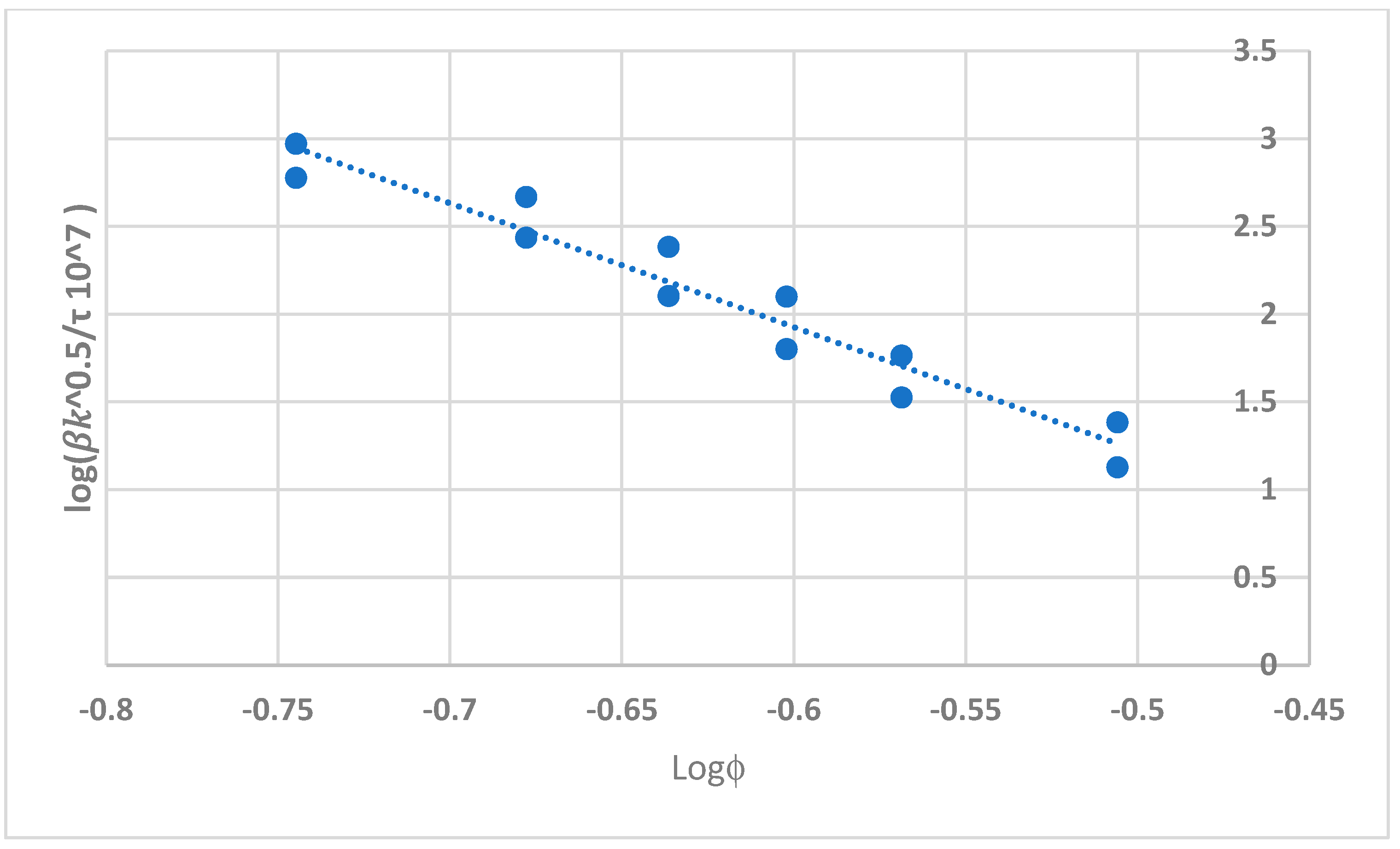
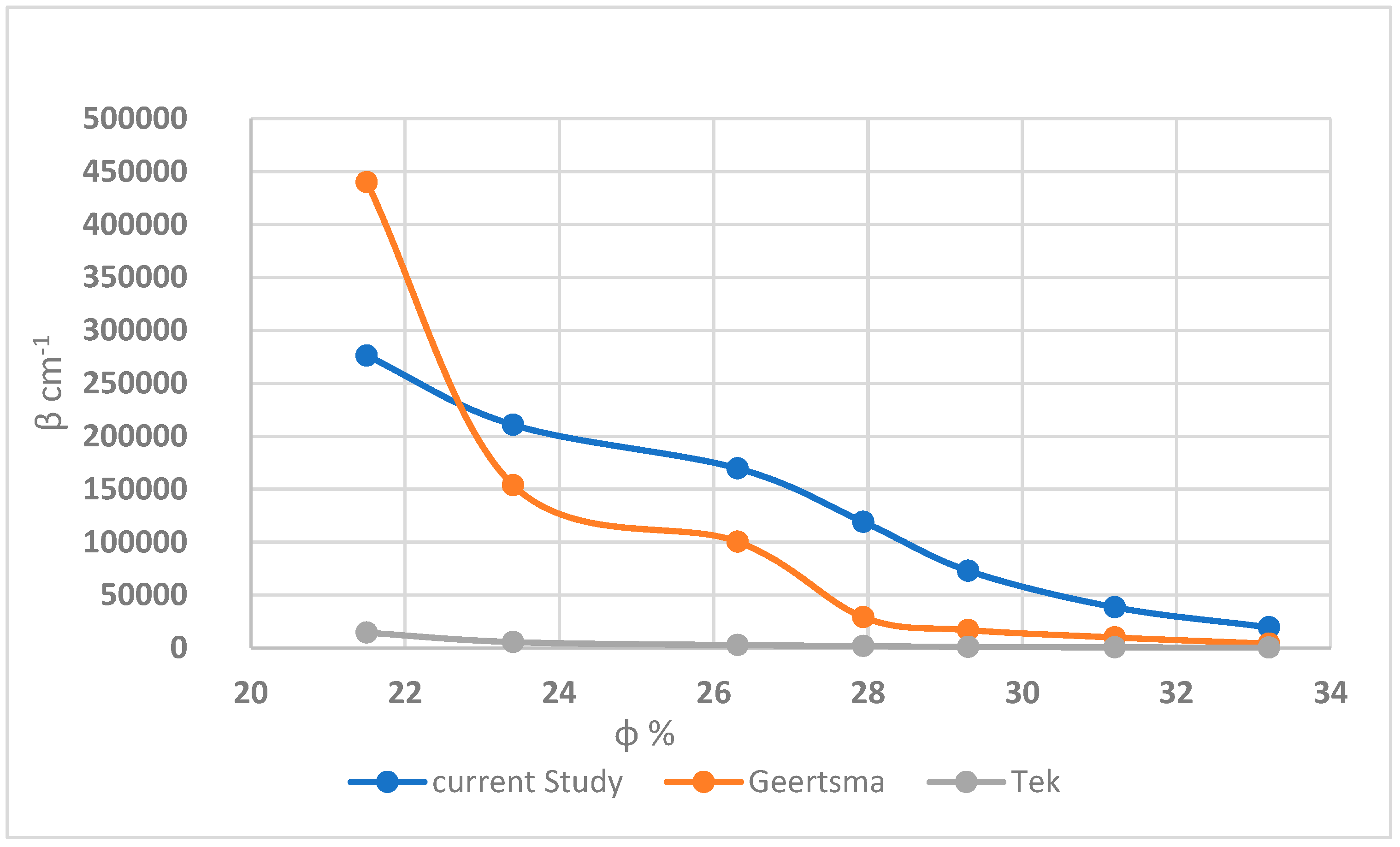
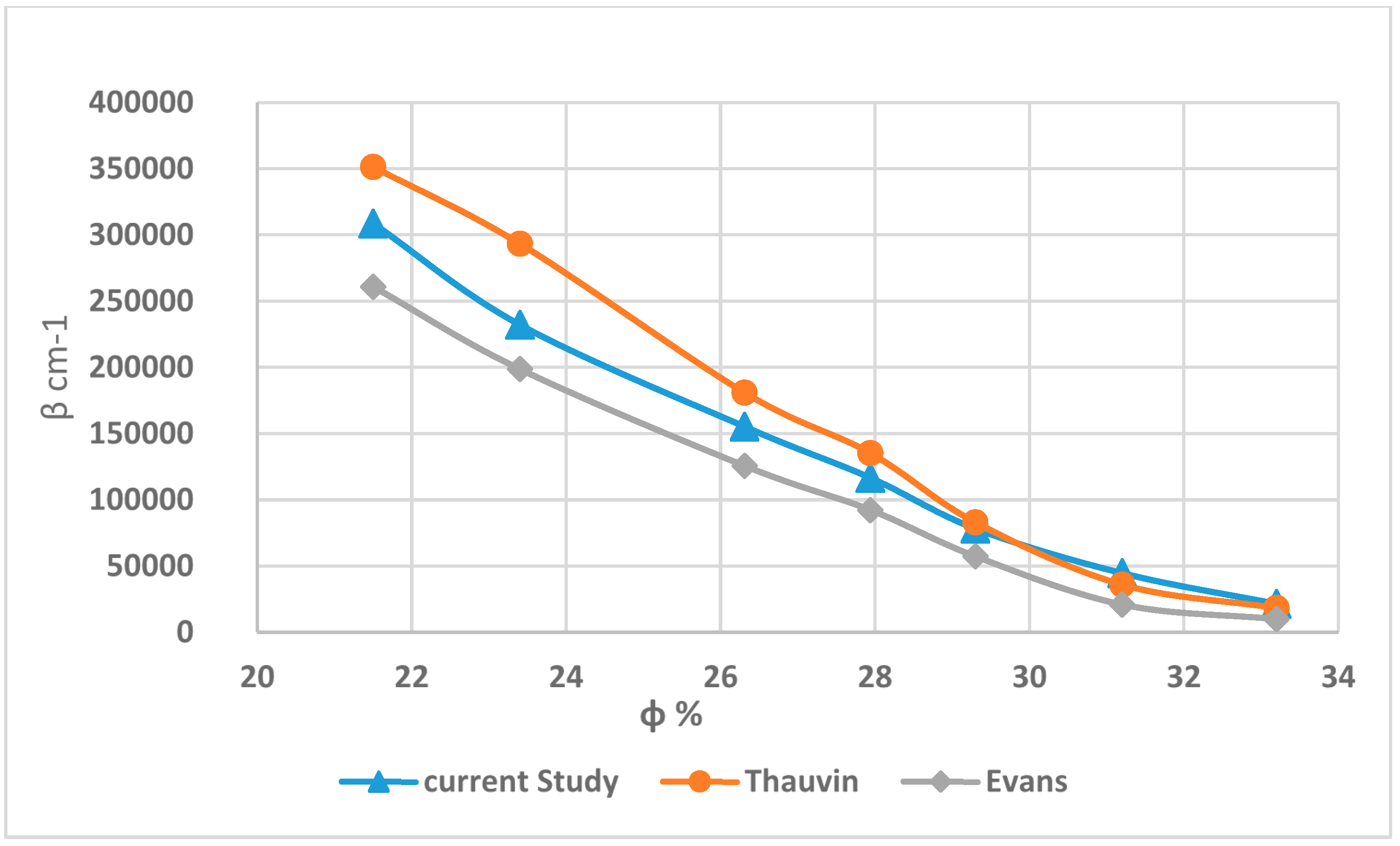
| Sample No. | Permeability (mD), k | Porosity (%), ∅ | Tortuosity, τ | Mean Pore Diameter M.P.D (µm) |
|---|---|---|---|---|
| Sample 1 | 2035.95 | 21.5 | 3.62 | 25.31 |
| Sample 2 | 3981.50 | 23.4 | 3.19 | 32.14 |
| Sample 3 | 6292.66 | 26.31 | 2.82 | 45.27 |
| Sample 4 | 8127.04 | 27.94 | 2.27 | 60.61 |
| Sample 5 | 12,281.50 | 29.3 | 2.10 | 81 |
| Sample 6 | 16,320.24 | 31.2 | 1.96 | 100 |
| Sample 7 | 26,151.72 | 33.2 | 1.7765 | 181.74 |
Publisher’s Note: MDPI stays neutral with regard to jurisdictional claims in published maps and institutional affiliations. |
© 2022 by the authors. Licensee MDPI, Basel, Switzerland. This article is an open access article distributed under the terms and conditions of the Creative Commons Attribution (CC BY) license (https://creativecommons.org/licenses/by/4.0/).
Share and Cite
Elsanoose, A.; Abobaker, E.; Khan, F.; Rahman, M.A.; Aborig, A.; Butt, S.D. Characterization of a Non-Darcy Flow and Development of New Correlation of NON-Darcy Coefficient. Energies 2022, 15, 7616. https://doi.org/10.3390/en15207616
Elsanoose A, Abobaker E, Khan F, Rahman MA, Aborig A, Butt SD. Characterization of a Non-Darcy Flow and Development of New Correlation of NON-Darcy Coefficient. Energies. 2022; 15(20):7616. https://doi.org/10.3390/en15207616
Chicago/Turabian StyleElsanoose, Abadelhalim, Ekhwaiter Abobaker, Faisal Khan, Mohammad Azizur Rahman, Amer Aborig, and Stephen D. Butt. 2022. "Characterization of a Non-Darcy Flow and Development of New Correlation of NON-Darcy Coefficient" Energies 15, no. 20: 7616. https://doi.org/10.3390/en15207616
APA StyleElsanoose, A., Abobaker, E., Khan, F., Rahman, M. A., Aborig, A., & Butt, S. D. (2022). Characterization of a Non-Darcy Flow and Development of New Correlation of NON-Darcy Coefficient. Energies, 15(20), 7616. https://doi.org/10.3390/en15207616









